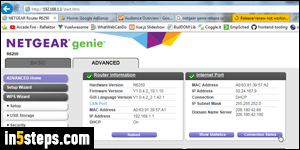

- CM1000 IP ADDRESS FOR NETGEAR ROUTER PASSWORD
- CM1000 IP ADDRESS FOR NETGEAR ROUTER MAC
- CM1000 IP ADDRESS FOR NETGEAR ROUTER WINDOWS
View the discussion here: Github Commit Comment Original TelnetEnable for Windows An in-depth analysis of the probe packet was recently conducted by Roberto Frenna. Even though the 'reserved' field is overwritten, the abnormal packet sent to the router will still unlock telnet.
CM1000 IP ADDRESS FOR NETGEAR ROUTER PASSWORD
This occurs with the newest modified version of the TelnetEnable utility due to 1) Netgear changing the daemon that listens for the probe packed to only accept the packet over UDP, and 2) The default password of 'Geardog' no longer works, and instead one must enter the web interface password, which can be up to 33 characters long. Note: It has also been discovered that the 'reserved' field of the probe packet can be overwritten up to 0x11 bytes by the password field. It is unknown what other capabilities may be similarly enabled via the 'reserved' field, or by other passwords. Note: The encrypted probe packet is sized as char output_Buf but only an encoded data length of size of 0x80 appears to be used by the code. It is simple a TCP send from the client to the router. The encrypted probe packet is then sent to telnet port (23) on the router using a TCP, or UDP socket in the standard manner.Ĭuriously, Netgear's Windows telnetEnable.exe program also includes the necessary support to decode packets incoming from the router, but there does not appear to be any two-way handshake implemented. The secret key used for Blowfish is “ AMBIT_TELNET_ENABLE+” concatenated by the password in the payload. The entire probe payload (including the reserved area, which is always null for this example) is then encrypted using the Blowfish algorithm, with reversed assumptions regarding the endianness of the data stream. The resulting 16 byte MD5 checksum/hash is then stored into the md5sum array of the probe payload. The MD5 checksum, or signature, is calculated for the contents of the probe payload MAC, username, and password fields, and is done using the normal three steps (MD5init, MD5update, MD5final) with the default RSA seed. The above payload formats are transformed by algorithms as follows:
CM1000 IP ADDRESS FOR NETGEAR ROUTER MAC
Payload is sent over TCP struct PAYLOAD_TCP_PLAINTEXTĬhar md5sum /* md5 hash 16 byte binary */Ĭhar mac /* null terminated string, 12 characters */Ĭhar username /* null terminated string */Ĭhar password /* null terminated string */įor newer Netgear routers (R6700, R7000, R7500) that use the modified TelnetEnable utility: The probe packet format in unencrypted form is as follows:įor older Netgear routers that use the original TelnetEnable utility: The TelnetEnable utility (see below) builds the probe packet using authentication data supplied on its command line. If the router accepts the probe packet and unlocks the CLI, then the CLI responds after a subsequent connection with a telnet client. The Netgear router CLI unlocking protocol establishes a TCP (for older Netgear routers), or UDP (for newer Netgear routers) connection on telnet port 23 to the router's LAN IP address, send an encrypted probe packet, then close the connection.


 0 kommentar(er)
0 kommentar(er)
